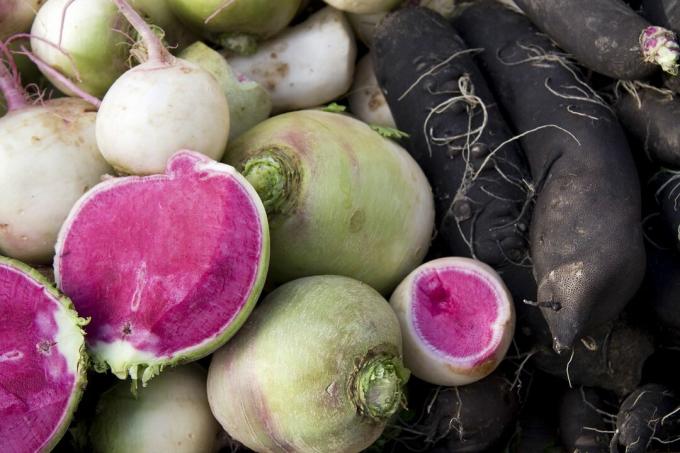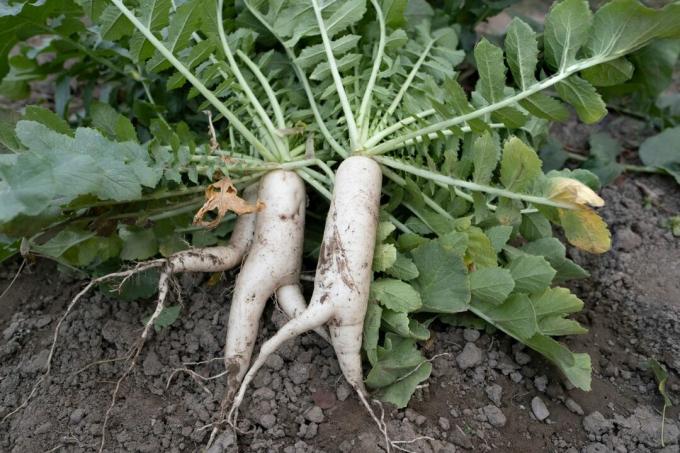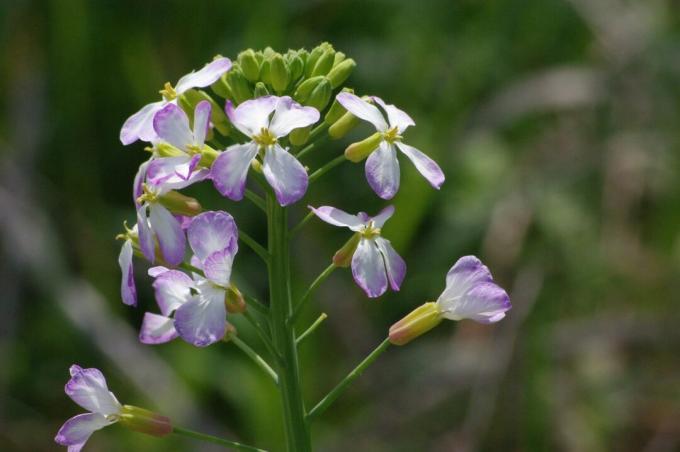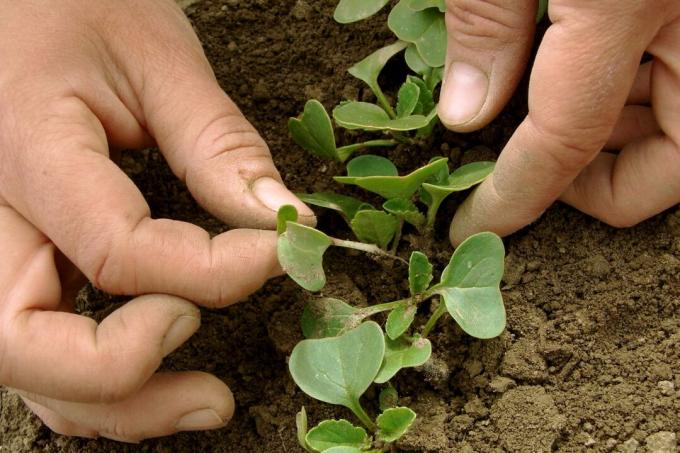Radish is a fast growing, healthy vegetable and can be grown almost all year round. With us you can find out everything about the origin and properties of the cabbage family and about planting radishes.

The garden radish (Raphanus sativus var. Niger) is one of the most popular vegetables in Asia. In Germany, the Bierradi is better known - but the radish can be used in much more diverse ways. We present the radish, its properties and requirements and also give tips on planting and caring for it.
contents
- Radish: origin and characteristics
- Planting radishes: sowing, location and Co.
-
Proper care
- Water and fertilize
- Common diseases and pests on radish
- Is radish hardy?
Radish: origin and characteristics
The radish, also called radi or councils, belongs to the cabbage family (Brassicaceae). He's close with radish (Raphanussativus var. sativus) and Oil radish (Raphanus sativus var. oleiformis) related. Radish probably comes from field radish (
Raphanus raphanistrum), which is located in southern Europe and Asia. The cultivated form of the radish came to Germany probably only in the 13th Century. Nowadays it is widespread as a vegetable all over the world. The word radish or radi comes from the Latin “radix”, which means “root”.Radishes form thickened beets from parts of the root and the shoot, the so-called hypocotyl. The round, oval or cylindrical radishes can be colored white, pink, red, purple, green, brown or black on the outside. Inside is the white, green to magenta-colored beet meat with its aromatic, hot, sweet taste. Like all cabbage plants, the radish also contains various mustard oils, which are responsible for the typical, kale-like, spicy taste. They have an antibacterial effect, which is why radish can be processed into cough syrup.

The radish root can reach deep into the ground and hardly forms any side roots. The leaves of the radish initially form a basal rosette of leaves with serrated, lobed to pinnate, sometimes long-stalked individual leaves. During the flowering period, the radish plants stretch out and form tall flower stems that are covered with alternate leaves. The long-day plants only bloom when the length of the day has exceeded a certain number of hours. This is usually the case between May and the end of June. The flowers of the radish arise on shoots 120 - 200 cm high. They sit in clusters in several groups and show a white to pink-colored flower with partly dark veins. Radishes are self-sterile, so they are strictly foreign pollinators and rely on insects. The flowers therefore provide both nectar and pollen. After pollination, elongated pods form in which the wrinkled, red-brown to dark-brown radish seeds mature. Even when the pods ripen, they don't burst, unlike Rapeseed (Brassica napus) or mustard (Sinapis). Radish is edible in all parts: the leaves, flowers and young pods can also be used in the kitchen.
What is the difference between radish and radish? Radishes and radishes belong to the same species, but each form a different variant. Radishes are often significantly larger and longer, their taste more aromatic, sweet to pungent hot. Radishes, on the other hand, have a mildly pungent taste and are harvested as tender, small turnips after a few weeks. However, they are so closely related that if they bloom at the same time they can interbreed with one another.

Planting radishes: sowing, location and Co.
The ideal location for radishes is on light to medium-heavy, crumbly soils with good water flow in full sun to partial shade. On soils that are too light, radishes tend to become furry and extremely hot, on too heavy soils the radish beet cannot be well developed and is difficult to harvest. Sludgy or heavy soils with a tendency to waterlogging are unsuitable, but can be done with a compost-rich potting soil like ours Plantura organic tomato & vegetable soil and sand to be mended. The introduction of organic matter also improves the soil in the long term, as soil life is promoted and the build-up of humus is strengthened.
Depending on the type of cultivation and variety, radishes are sown directly outdoors or in cold storage. Pre-cultivation is possible, but direct sowing creates much nicer beets and deeper roots, which makes care and harvest easier. Some radish varieties are suitable for summer cultivation with sowing in spring, others are sown as storable autumn and winter radish from August. In unheated, sheltered cold houses, radishes can also be cultivated over the winter. Due to the large variety of varieties and their suitability for cultivation at different times of the year, radishes can be sown every two weeks and thus harvested almost all year round. First of all, the soil is tilled, removing unwanted weeds and loosening the soil generously. The radish seeds are then sown closely in rows with a distance of 25-30 cm and later separated at a distance of 20 cm between the individual radish plants. The seeds are placed 1 - 2 cm deep in the soil or the potting soil and poured vigorously. At an optimal germination temperature of 14-15 ° C, the first seedlings can be seen after eight to ten days.

Good and bad neighbors for radish: One Mixed culture with radishes it is particularly worthwhile, as some planting partners keep pests away and do not pass on diseases. Good neighbors for radishes are salads (Lactuca), carrot (Daucus carota), celery (Apium graveolens), Salsify (Scorzonera hispanica), spinach (Spinacia oleracea), Tomato (Solanum lycopersicum), paprika (Capsicum annuum), pea (Pisum sativum) and Bean (Phaseolus vulgaris). Bad neighbors are, however, related cabbage plants (Brassica), Cucumber (Cucumis sativus) and Onions (Allium cepa).
Fast-growing radish varieties can be grown as a preceding crop or a subsequent crop. In the greenhouse, the hot beets thrive in early spring and are harvested until the beginning of May tomatoes, peppers and co. Move in. Autumn and winter radishes can be sown from August onwards as a follow-up after early carrots, French beans, peas or salads. Radish shouldn't be grown directly after other cabbage plants in order to avoid the dreaded one Carbonic hernia (Plasmodiophora brassicae) to escape. A break from cultivation of four to five years is therefore recommended.

Proper care
The care of radishes is quite easy, also because the culture is fast-growing. Two to three weeks after sowing, the plants are separated to their final distance. Regular chopping between the rows reduces the growth of weeds, which is particularly important in the seedling phase. We present further maintenance measures in the following paragraphs.
Water and fertilize
Fertilization and watering are especially important when growing radish, as drought, heat and lack of nutrients lead to furry, acrid hot and lignified beets. In extreme cases, the radishes shoot out of stress and bloom prematurely. A regular water supply is therefore particularly necessary in dry periods.
Radish is one of the middle eater and should be supplied with sufficient nutrients, especially when the beet is growing. Our Plantura organic tomato fertilizer is specially tailored to the needs of tomatoes and other vegetables. It works over a period of about three months and releases the nutrients it contains slowly and evenly. This effectively prevents the plants from being washed out or over-fertilized. The animal-free granulate fertilizer can be worked into the surface for sowing when loosening the soil. Just before sowing radishes, fresh manure or compost should not be incorporated, as this is far too hot for radishes and can damage the plants.
Common diseases and pests on radish
Radish is a very robust vegetable, but various pests and diseases can occur in unfavorable growing conditions:
- Earth fleas (Psylliodes): Tiny, jumping, shiny black beetles cause leaves that are perforated like a sieve. Regular chopping between the rows, fine-meshed vegetable protection nets and tansy broth reduce the infestation.
- Cabbage fly (Delia): The maggots of the cabbage fly eat at the roots of the cabbage family and young plants often die off completely. Vegetable protective nets and a mixed culture with tomatoes and celery keep cabbage flies away.
- Mealy cabbage aphid (Brevicoryne brassicae): White-gray lice suckle the young shoot tips. Beneficial insects against aphids and a mixed culture with beans reduce the infestation.

- Leaf spot disease: Various fungal pathogens cause dark spots on the leaves, which themselves are often not dangerous, but to other diseases or pests on radish Clues.
- Wrong mildew (Peronospora parasitica): On the underside of the leaf, gray-white fungal lawns form, which are reflected on the upper side as yellow spots. Warm, humid weather promotes the disease, so sufficient ventilation and planting spacing should be ensured.
- White rust (Albugo candida): Shiny white fungal pustules on the underside of the leaf occur especially when the air humidity is high and spread quickly in the stand due to wind and water. Infested leaves should be removed and disposed of with household waste.

Is radish hardy?
Young, ripe radishes are not hardy and are therefore completely harvested and stored in autumn. Adult autumn radishes can withstand freezing temperatures down to around - 9 ° C and can theoretically be harvested all winter in frost-free soil, but at this stage they are often too woody. The beets can also burst open in frosty conditions and are then no longer edible. A winter protection with foil or fleece or the cultivation of radish in the insulating, An unheated greenhouse is a better alternative to outdoor cultivation if the beets are not stored can be.
The first aromatic radish beets can be harvested just a few weeks after sowing. We give tips on harvesting and storing radishes.
